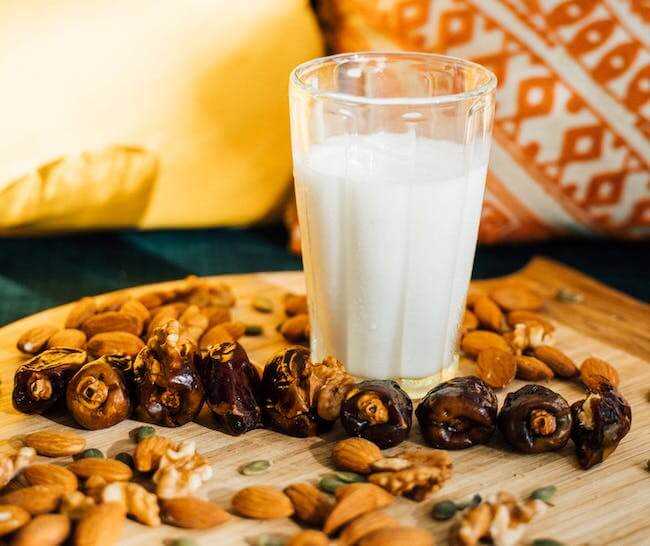What Happens in Your Body When You Eat Dairy?
Digestion begins as soon as food enters your mouth. Enzymes activate in your saliva, and the breakdown continues as your meal moves through your intestinal tract.
Dairy, specifically the lactose molecule, breaks down when it arrives in the small intestine1. An enzyme called lactase splits lactose into smaller molecules called glucose and galactose. These smaller molecules are converted into usable energy and are much easier for your body to absorb.
Depending on your unique response, lactose is unlikely to cause blood sugar spikes. Dairy products also contain protein and fat which decreases the glycemic load because these macronutrients are digested slowly.
Pairing a carbohydrate with protein or fat can offset the effect on your blood glucose. Fortunately, most dairy products already contain two or sometimes all three of the macronutrients.
{{mid-cta}}
What Is Lactose Intolerance?
Some individuals can’t tolerate lactose from dairy products because their bodies don’t produce enough lactase to break it down2. The result? A range of unpleasant gastrointestinal symptoms includes painful cramping, bloating, the urgency to use the bathroom, and diarrhea.
Certain ethnic groups are at higher risk of developing lactose intolerance earlier in life, including Africans, Native Americans, Hispanics, and Asians.2
Occasionally people are born lactose intolerant, but it’s uncommon1. Adults usually develop lactose intolerance as they age, which makes sense since healthy adult diets tend to focus less on dairy than those of a developing child.
There is no cure for lactose intolerance. Treatment is to avoid lactose or use Lactaid which contains lactase to help with digestion 2,3.
Sources of Lactose
Lactose is naturally present in all animal-based dairy products. Milk from different animals contains varying amounts of lactose. Goat’s milk contains less lactose than cow’s milk and is often better tolerated by people with lactose sensitivities3.
Common Sources of Lactose Include:
- Milk and cream
- Powdered milk or canned milk products
- Buttermilk
- Ice cream
- Yogurt
- Sour Cream
- Cheese
- Whey
You may have seen lactose-free options at the grocery store. These dairy products contain lactase, which helps with digestion.
The nutrient profiles of regular dairy products and lactose-free products are the same, meaning regular cow’s milk contains the same amount of sugar as lactose-free milk.
What Are the Nutritional Benefits of Dairy?
All dairy products are rich in calcium and vitamin D. Calcium is an essential mineral and needs to be replenished daily through diet. It has a vital role in cell signaling, bone integrity, heartbeat regularity, and healthy dentition4.
Although you can take calcium supplements, food sources of calcium are the most bioavailable and will be best absorbed in your body.
Dairy products, especially yogurt and cottage cheese, are rich in protein5. Protein is critical for satiety, building hormones, and blood sugar management. It slows down digestion and reduces the chances of a sugar spike.
All dairy products are available with a wide range of milk-fat percentages (MF%). A higher fat product is better for stabilizing blood sugars. Instead of choosing a flavored yogurt, choose a plain full-fat greek option instead, and add ingredients at home to make it more exciting. Popular blood-sugar-friendly toppings include nuts, seeds, cinnamon, berries, and nut butters.
<p class="pro-tip"><strong>Learn more about </strong> <a href="/blog/yogurt-metabolic-health">yogurt and metabolic health</a>.</p>
Is Dairy Bad for Blood Sugar Levels?
Different dairy products contain varying amounts of carbohydrates, which may influence your blood sugar. Fortunately, the overall impact of dairy on blood sugar appears to be minimal, and some dairy consumption can be part of a healthy diet5.
Not all dairy products are created equal. Anything flavored will likely contain added sugars, which can spike blood glucose5,6. The only way to know for sure if a product contains added sugars is to read the label and the ingredients6.
The language can be hard to understand at first but with practice, you will become more fluent.
Common terms to identify added sugars:
- High fructose corn syrup
- Maltose/Dextrose/Glucose/Sucrose
- Cane sugar
- Sugar or brown sugar
- Honey or maple syrup
- Malted barley extract
To best manage your blood glucose, choose plain or unflavored dairy products whenever possible. You can naturally enhance the flavor at home by adding fresh fruits, nuts, or spices. You can also lean towards savory tastes and create a garlic yogurt dip at home to pair with high-fiber vegetables.
Dairy Alternatives
There are several dairy alternatives on the market. These products are made using plant-based ingredients and are appropriate for individuals with lactose intolerance or who follow a vegan diet (no animal products).
Dairy alternatives are usually lower in calcium and protein compared to cow’s milk, and they are fortified to increase their nutritional value.
Common dairy milk alternatives include:
- Soy milk
- Almond milk
- Coconut milk
- Cashew milk
- Oat milk
- Rice milk
Similar to dairy products, flavored dairy alternatives usually contain large amounts of added sugar and can spike blood glucose. Choose plain or unsweetened dairy alternatives instead.
<p class="pro-tip">Read: 9 Best Vegan Protein Options</p>
Which Dairy Alternative is the Healthiest?
Soy-based products are closest to cow’s milk dairy because they naturally contain similar amounts of protein. Soy products are also rich in omega-3 fatty acids and phytosterols, both of which contribute to excellent cardiovascular health7.
Coconut products contain the highest amount of saturated fats compared to other dairy alternatives. Saturated fats will not directly impact your blood glucose, but they may raise your LDL cholesterol (low-density lipoprotein)8. This area of nutrition is being heavily researched and the role of saturated fats and cardiovascular disease is controversial8.
For now, a good option is to choose a variety of dairy alternatives because each product offers different nutrients and flavors. You may have to experiment with a few brands to find a product you love.
Are Sugar-Free Dairy Products Good For Me?
Sugar-free dairy products are sweetened using artificial sweeteners or other sugar substitutes.
Most health care professionals discourage the frequent intake of artificial sweeteners. Although these products can be a valuable tool to help you wean off of high sugar foods, they are not recommended for long-term intake6.
The ultimate goal is to encourage you to pick wholesome natural low-sugar foods as often as possible. Try to develop a habit of reading the food and nutrition labels before you buy a new product. Choose unflavored and unsweetened options whenever possible, and increase the appeal by getting creative with your toppings at home.
Want to learn more about nutrition and blood glucose management? Check out more articles here!
- Item 1
- Item 2
- item 3
Topics discussed in this article:
References
- Fernando, J. “Lactose Intolerance (for Teens) - Nemours KidsHealth.” Kids Health, March 2020, https://kidshealth.org/en/teens/lactose-intolerance.html. Accessed 23 March 2022.
- “Lactose Intolerance.” Wake Gastroenterology, https://wakegastro.com/patient-info/patient-education/lactose-intolerance/. Accessed 23 March 2022.
- “Managing Lactose Intolerance.” Unlock Food, 7 September 2019, https://www.unlockfood.ca/en/Articles/Allergies-and-Intolerances/Managing-lactose-intolerance.aspx. Accessed 23 March 2022.
- “How Is Calcium Connected to Aging, Diabetes, Hypoglycemia, and Falls? | ADA.” American Diabetes Association, https://www.diabetes.org/healthy-living/recipes-nutrition/calcium-connected-to-aging-diabetes-hypoglycemia-falls. Accessed 23 March 2022.
- “Diabetes Superstar Foods | ADA.” American Diabetes Association, https://www.diabetes.org/healthy-living/recipes-nutrition/eating-well/diabetes-superstar-foods. Accessed 23 March 2022.
- “Get to Know Carbs | ADA.” American Diabetes Association, https://www.diabetes.org/healthy-living/recipes-nutrition/understanding-carbs/get-to-know-carbs. Accessed 23 March 2022.
- Messina MPH RD, Virginia. “Soyfoods and Heart Disease.” Today's Dietitian, vol. 18, no. 4, 2016, p. 18. Today's Dietitian, https://www.todaysdietitian.com/newarchives/0416p18.shtml. Accessed 23 March 2022.
- “Saturated Fat.” American Heart Association, 1 November 2021, https://www.heart.org/en/healthy-living/healthy-eating/eat-smart/fats/saturated-fats. Accessed 23 March 2022.
































